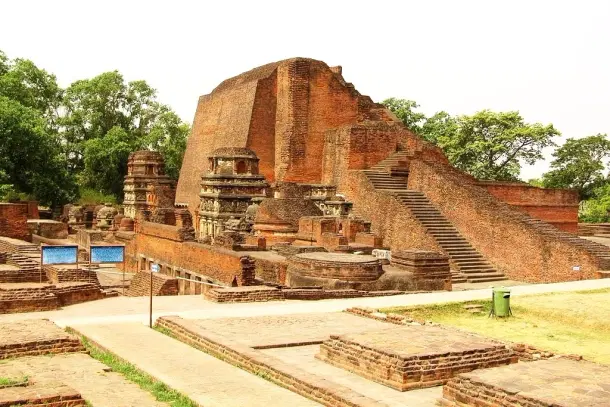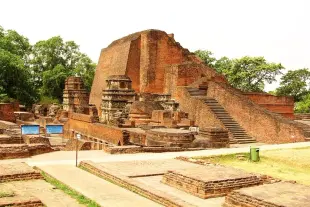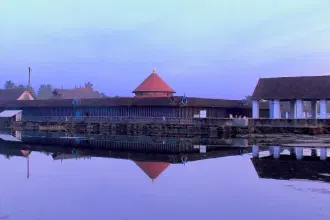Heritage
Bharat’s Past, Bharat’s Future: How Public History Can Shape A Civilisational Renaissance
Vivek Rallabandi
Oct 04, 2025, 03:02 PM | Updated Oct 05, 2025, 10:52 AM IST
Save & read from anywhere!
Bookmark stories for easy access on any device or the Swarajya app.


As Bharat approaches a century of independence, the Government of India has outlined a roadmap for the nation's development by the time it reaches this key milestone. This vision is "Viksit Bharat 2047," which calls for increased development and modernisation, economic self-reliance, and bolstered national security.
Crucially, the Indian government has also recognised that civilisational growth, too, is a key plank of this vision of a developed India. For instance, the Indian Knowledge Systems approach, spearheaded by the Ministry of Education, endeavours to draw on Bharat's civilisational wisdom in such diverse fields as Ayurveda, Artha Shastra (statecraft), Vyakarana (Sanskrit grammar), and Nyaya (an Indian system of logic), and Yoga, and seamlessly integrate them with modern systems of education.
Under Prime Minister Narendra Modi's leadership, the Indian government has also acknowledged the role of historical sites and museums in contributing to India's intellectual development. In June 2025, speaking at the annual general meeting of the Prime Ministers' Museum and Library (PMML) Society, the Prime Minister "advocate[d] for a nationwide modernization of museums," nodding to their significance as sites where visitors "could experience the nation's history directly."
The Prime Minister's remarks underscore the centrality of place in cultivating civilisational consciousness. Undoubtedly, the seemingly ever-expanding digital world, replete with virtual reality and Artificial Intelligence technologies, has allowed us to experience places that we have never physically set foot in. And one certainly does not have to be physically present at a particular historical site to learn about the events that occurred there.
Yet there is certainly something special, ineffable, perhaps, about actually standing in the places where history was made, history which the visitor thus far only heard and read about. The same goes for museums; while most people around the globe have seen a picture of the Mona Lisa, millions still throng to the Louvre in Paris every year to catch a glimpse of the iconic painting.
The primacy of place in rousing a nation's historical consciousness is borne out well by the example of the United States. Of course, the United States was principally established by immigrants from Europe and their descendants. The land, in and of itself, then, did not necessarily hold meaning for the settlers, in that it was not imbued with the history of their ancestors in the way that Europe was.
Further, many of the early American settlers were Anglo-Saxon Protestants. During the Protestant Reformation in the sixteenth century, "Protestants contested sacred space, saints, and relics, all of which featured in Catholic traditions of physical pilgrimage." As such, pilgrimage, religiously speaking, was discouraged in the Protestant tradition, in contrast with Catholic veneration of sacred religious spaces and relics.
Therefore, meaning-making in the heretofore alien New World hinged on conferring the land with a certain sacrality. Thus, the sites of important historical events in the United States have, over time, effectively been designated places of pilgrimage in the collective American consciousness. These places are locations where millions of Americans throng every year to pay homage to important personages and events in the nation's history.
A prime example of such a location is Gettysburg. Gettysburg, a small town in south-central Pennsylvania, approximately 90 minutes from Washington, D.C., was the site of one of the most important battles of the American Civil War. The Union and Confederate armies fought at Gettysburg for three days in July 1863.
The Union Army achieved a hard-fought yet bloody victory; there were about 50,000 deaths on both sides. The battle marked a turning point in the Civil War, paving the way for the Union's eventual victory in 1865 and the abolition of slavery through the 13th Amendment to the Constitution.
Gettysburg was also the site of the Gettysburg Address, which President Abraham Lincoln delivered in November 1863 at the dedication of the national cemetery where Union soldiers killed at Gettysburg were interred. In a speech that has been oft-cited in the succeeding centuries, Lincoln underscored the sanctity of the Gettysburg battlefield.
"But, in a larger sense, we can not dedicate — we can not consecrate — we can not hallow this ground," Lincoln noted. "The brave men, living and dead, who struggled here, have consecrated it, far above our poor power to add or detract."
Embracing Lincoln's stirring elucidation of Gettysburg's sanctity, tourists began to flock to this small town in the decades following the Civil War, wishing to see for themselves the places where the battle occurred. This has continued to the present day, as Gettysburg hosts hundreds of thousands of tourists every year.
The battlefields themselves, vast stretches of picturesque land, were silent witnesses to the three days of fighting that occurred upon them. On their own, they cannot tell the story of the conflict that they bore.
So how can the visitors actually understand and appreciate the details of the conflict? How can they imagine the experiences that the civilians of Gettysburg had while Confederate soldiers invaded their town and shattered their peaceful existence? How can they picture the vivid scenes of battle that took place on the now-quiet battlefields they traverse?
I discovered the answers to these questions during the four years that I was a student at Gettysburg College, an institution situated in the heart of historical Gettysburg. Founded in 1832, the college's history is deeply intertwined with the Battle of Gettysburg.
The college's campus actually played host to part of the battle, and a prominent campus building, Pennsylvania Hall, was used as a field hospital to treat wounded soldiers after the battle. Attending a historically significant college was a treat, and it was all the more fitting given that I studied history and public history while there. The latter subject contains the answers to the questions I posed above.
In a nutshell, public history, which can be considered a sub-discipline of history, provides a framework for how to connect the public at large, not just academics and history students, with history. Gettysburg College has a robust public history programme, and I was able to see the concepts that I learned in the classroom manifest themselves in action around me, in Gettysburg.
Let me offer a few examples to practically illustrate public history's applicability and its potential as a discipline in the Bharatiya context.
One of the most prominent elements of Gettysburg's public history infrastructure is the battlefield tours that many visitors take during their "pilgrimage." Walking through Gettysburg, your attention is often captured by the large, double-decker tour buses that traverse through the town's streets.
Particularly in the summer months, many visitors sit on the top floor of the open-air buses, where they can soak in the history and sun in equal measure. The tour buses embark from a dedicated bus tour centre and, for two hours, take visitors through the battlefields and the town.
Visitors benefit from the engaging and historically accurate explanations that licensed battlefield guides (LBGs) provide during the bus tour. Becoming an LBG is no mean feat; aspirants must pass a multi-step examination, which includes oral and written parts, that has a pass rate of only about 10%. The process, which is administered by the National Park Service, has been termed "the toughest test in American history."
The National Park Service is an organ of the US government and manages both natural and historical sites throughout the United States. It is reputed for its knowledgeable field staff, known as park rangers, who are distinguishable by their trademark green apparel and their wide-brimmed hats.
What is remarkable to me about Gettysburg's bus tours is the fact that the large majority of people who attend them are not historians by profession or even people with intense knowledge about the Civil War and the battle. Rather, most of them, and indeed, most visitors to Gettysburg are people for whom the town is an idea that is intrinsic to their identity as Americans.
For parents that bring their school-aged children to Gettysburg, there is also, in many cases, a sentimental significance to the visit, for many of those parents came to Gettysburg themselves with their parents, growing up. Thus, the parampara-based remembering and passing down of history has become part of the American tradition.
All this is to say that the visitors that take Gettysburg's battlefield bus tours may not remember every detail that the guide mentioned during the two-hour tour. And, in public history, that's alright. Unlike a school history class, where committing facts to memory and writing analytical essays are necessary to pass, public history aims to foster a genuine appreciation and interest in visitors about the places they visit.
Even if a visitor takes away one or two points from a visit that make that historical site memorable to them, the public historian has succeeded at their job. In public history, it is critical to connect with visitors based on their age, background, and life experiences to ensure that they genuinely engage with the site or museum they are visiting.
It is axiomatic that a twelve-year-old student and a sixty-five-year-old retiree may not necessarily benefit from precisely the same historical engagement at a site. At Gettysburg, I appreciated the focus on youth engagement that ran throughout the historical programming.
For instance, the town has a dedicated "Gettysburg Children of 1863" museum that is designed specifically for children. The museum allows children to immerse themselves in the history of the battle from the perspective of a child living in Gettysburg during the battle in 1863.
The approach is a powerful one, in that it drives home for children that, despite the centuries that have passed since the battle, the fundamental nature of childhood has endured. All of a sudden, history changes from an ancient relic to something that we too can conceive of and relate to in the present.
The immersive experiences in Gettysburg, for example, the "Caught in the Crossfire" exhibit at the Beyond the Battle museum, which is an audio-visual simulation of a civilian home during the battle, go a long way in bridging past and present.
Similarly, the National Park Service's "Junior Ranger" programme at Gettysburg and other sites across the United States allows children and youth to obtain a special badge upon completing a certain number of activities related to the site they are visiting. The badges are collectible and include the name of the site and are a fun way for children visiting historical sites to engage with history in an age-appropriate manner.
There is much more that I can say about Gettysburg and its multifaceted public history offerings, but I think this is a suitable overview. Gettysburg offers a promising example for how public history, as a field, can blossom in Bharat.
Bharat has no shortage of historical sites, including forts, temples, homes of historical personages, stupas, and more. The work that must be done in this arena, then, is two-fold: the first part is to attract visitors to these historical sites, and the second part is to create an effective interpretive infrastructure to serve visitors once there.
In terms of the first part, the ground is certainly more fertile than it previously has been. The broader civilisational resurgence in Bharat has meant that its people have become more aware of, and proud of, previously little-known historical figures and events.
Film has been a factor in this transformation; for instance, the Oscar-winning historical fiction film RRR catapulted Telugu freedom fighter Alluri Sitarama Raju to a global stage. It then becomes incumbent to link the cinematic and the real. In Sitarama Raju's case, for instance, this could entail promoting sites such as his tomb, located in Anakapalli District of Andhra Pradesh, as a site of pilgrimage for some of his on-screen admirers.
The second part, how to actually develop these historical sites and present them to visitors that come there, is where public history comes into play. Teaching public history in colleges and universities would ensure that a cadre of well-trained public history professionals emerges, who can do the important work of interpreting Bharat's many historical sites for the public.
The United States has an array of undergraduate and graduate public history programmes that prepare students for a career in the field. Unfortunately, India has very few. Creating public history programmes in colleges and universities in India is crucial to strengthening the field here.
Of course, the graduates of these proposed public history programmes should have jobs that are tailored to their skills and training. This points to public history's economic potential: it creates jobs and opens the door for various other businesses in the vicinity of historical sites, such as restaurants and hotels, to serve visitors.
If you don't believe me, just come to Gettysburg sometime, walk the downtown streets, and look at the many thriving businesses in what would otherwise be a sleepy rural Pennsylvania town.
There is something profound about people of a given country being aware of and taking the time to visit sites that are linked with their nation's past. Such an action reflects intellectual and civilisational growth in that nation.
Bharat is fortunate that, for generations, its people have undertaken spiritual pilgrimages to various kshetras that are seen as repositories of abiding shakti. Many of our temples are also places of great history, and a truly Bharatiya public history model can wed spirituality and history together for visitors to these sites.
Given that pilgrimage is already a natural experience for the bharatiya mind, extending this principle to historically driven travel is but a natural progression. After all, are sites like the place where Alluri Sitarama Raju, whose fight was profoundly driven by his Hindu faith, laid down his life not spiritually significant to us, too?
This is the promise that public history holds for Bharat on multiple levels: intellectual, economic, spiritual, and civilisational. It can be a key plank in Bharat's civilisational resurgence through the collective efforts of government agencies such as the Archaeological Survey of India, educational institutions, private organisations, corporate donors, and ordinary citizens. Each group has its own unique but important role to play.
Public history is a discipline that holds enormous promise for the nation, and one that all of us should embrace.





